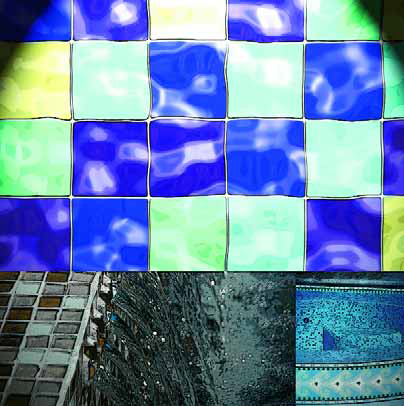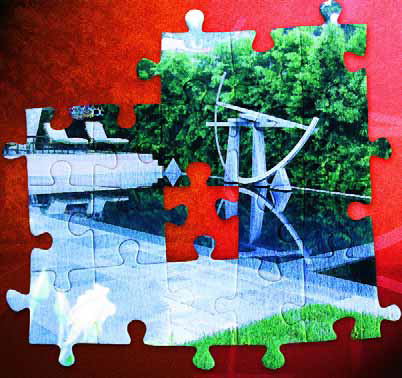In a word, the project pictured in these pages is about the power and value of collaboration. I was originally called in to consult on the planting design for a backyard in need of remodeling. A couple of months into the process, the clients informed me that they hated their existing pool and asked me if I knew of a pool contractor named Randy Beard, who had worked with them previously on another of their residences. I offered to contact Beard and discuss the project with him: We had known about each other for years, mostly through WaterShapes columns and articles, but to that point we'd never had the opportunity to work together. The clients had said they wanted to remove the spa from the pool and perhaps raise it to create a spillway into the pool. Beard and I quickly came to the same conclusion: Revamping the pool would neither be cost-effective nor would it achieve the outcome the clients desired. Pointed discussions and budget reviews led to the determination that the existing pool/spa combination should be abandoned in favor of something that worked better to generate a sense of space, greater functionality and enhanced aesthetic appeal. Although we didn't set out to tackle the project as a team, Beard and I wound up working hand in glove with a synergy that was valuable to both of us - especially in
As watershape designs become increasingly creative and complex, the demand for more precise methods of engineering their structures has grown as well. To meet that need, observe Ron Lacher and Aaron Cowen of Pool Engineering, experts like them are turning to advanced three-dimensional modeling technology - systems so sophisticated that they make it possible to develop plans for daring projects such as they one they describe here. It's easily the most sophisticated watershape structure we've ever engineered. The pool/spa combination, not yet built, will rise some 50 feet above grade on a cliff behind a home in the densely populated Hollywood Hills near downtown Los Angeles. As conceived, the vanishing-edge pool will sit a full ten feet below the spa in a complex monolithic structure. Supporting the entire affair will be
We've always based our work as tile artists on refusing to allow existing rules and conventions to get in the way: We push at all boundaries and always seek something more exciting to create. That undaunted spirit of breaking new ground started with my parents, who established Craig Bragdy Design Ltd. in Wales just after World War II. Jean and Rhys "Taffy" Powell met in art school, had four rowdy boys and started the business by producing decorative ceramic products - coffee and tea cups, dishes, salt and pepper sets and a host of other smallish daily items. Even then, they were swimming against the tide: In the postwar United Kingdom, most people were interested in purely practical products and certainly
The latest generation of Las Vegas hotels and casinos offers an amazing showcase for pools, fountains and watershapes of every shape and size. In fact, for many such properties, the presence of these increasingly imaginative watershapes is crucial to defining their appeal for huge numbers of guests and visitors. As these properties and their watershapes have become more elaborate and unconventional, they've presented designers, engineers and builders with greater and greater technical challenges - many of them carried in the plain fact that water can inflict a great deal of damage on these facilities if it is not properly contained and controlled. In our end of the watershaping trades, the visual and sensory arms race has challenged the waterproofing industry to step up to the plate and manage the integrity of every nook and cranny of every vessel, be it wide or narrow, curved or straight, below-grade or
For many clients, the decision to purchase a watershape represents the second or third largest expenditure they'll ever make. As a result, understanding the psychology that drives client decision-making is an issue that cuts very close to the heart of what we all do for a living. To gain a firmer grasp on what makes clients tick, I recently turned to Trading Up, an insightful book by Michael Silverstein and Neil Fiske (Penguin Group, 2005). The 300-page text explores the issue of why people choose to spend more money in some areas of their lives while allocating less to others - a fascinating approach that sheds a great deal of light on the dynamics of making large financial decisions. The premise of Silverstein's and Fiske's discussion is that most people have an idiosyncratic curve of preferences when it comes to making significant purchasing decisions. Why, for example, will some people will set aside substantial resources to buy a Mercedes or Jaguar while spending (relatively) much less on
I know I've quoted or paraphrased Ernest Hemingway on this point before, but it bears repeating once again: Anything that was ever any good, you pay for. I'd go so far to say I've based my entire business philosophy on that basic idea. For one thing, there's an essential truth to what he's saying. For another, I see its clear application to watershaping on a variety of levels - particularly when it comes to the materials we use in creating our "art." Indeed, a huge part of giving clients the unique elegance and beauty they so often crave involves understanding and appreciating
In the October 2005 issue of WaterShapes, I discussed a project that had tested my abilities and helped me to grow as a landscape designer. To that point in my career, I had functioned mainly as a designer focused on planting design. It was quite a step for me to accept the greater responsibility that came with a project that put me in charge of work on the total environment - pool, spa, deck, outdoor amenities and artwork placement as well as the planting plan. I knew going in that project management is a challenge no matter the size or scale of the job. Coordinating various trades, anticipating schedules and materials needs, making on-site design decisions and covering all
Robert Frost once wrote, "I took the road less traveled and that has made all the difference." As we approach the New Year, I can't think of a more fitting theme for the watershaping industry. If we consider where we were just ten years ago and compare that situation to the world in which we live and work today, it's clear that the industry as a whole has changed immeasurably - and, I think, for the good. I can say further and without fear of contradiction that those who have embraced the "road less traveled" and faced the future with creativity, hope and optimism have flourished, while those who have clung to the paradigms of the past are not so well positioned to
For all the beauty and creativity that characterize the finished watershapes we cover in our magazine, I often find just as much inspiration in the stories behind these polished works of art. Quite often, in fact, I perceive that these
All artists and designers have to come from somewhere, creatively speaking. In our case, we came to watershaping via the world of glass arts and crafts, a starting place that led us first to create unusual sculptures in glass and light - and then to carry our work out into landscapes and especially into settings that feature water. In collaborating mostly with architects and landscape architects and designers, we at SWON Design in Montreal have found what we believe to be an incredibly rich vein of aesthetic potential. Indeed, we have come through the years to recognize with greater and greater profundity that water






















